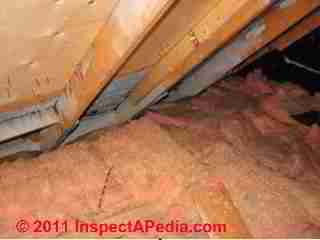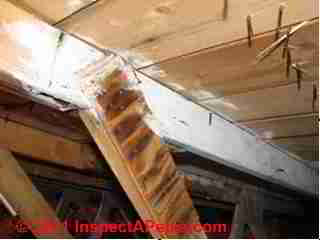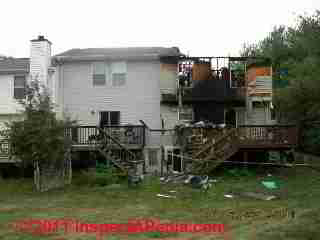 Mold Contamination in Fire Damaged Buildings
Mold Contamination in Fire Damaged Buildings
- POST a QUESTION or COMMENT On Distinguishing Between Fire & Mold Stains in Buildings
Building mold contamination resulting from the extinguishment of a building fire:
This article discusses how fire damage and mold damage might be recognized in a building and how we might distinguish between black stains and white sealant paints used in both fire damage repair and mold remediation projects.
InspectAPedia tolerates no conflicts of interest. We have no relationship with advertisers, products, or services discussed at this website.
Post-Building Fire Mold Contamination
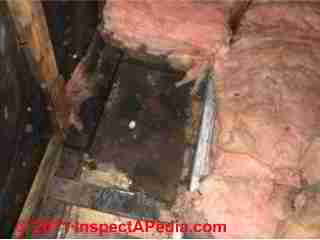 Mold contamination can follow a building fire and may occur in building cavities nowhere near where the fire itself occurred.
Mold contamination can follow a building fire and may occur in building cavities nowhere near where the fire itself occurred.
Here we explain when, where, how and why a building may becomemold contaminated following a building fire as water from fire extinguishment (or from a building left open to the weather) travels through building cavities.
[Click to enlarge any image]
Reader question: I found your website and found it extremely helpful. However I have a very particular situation and would like to have your suggestions and comments. Here are the series of facts leading to this e-mail to you.
Type of house: 1983 Canadian style with drooping front roof purchased January 2011
Information from seller: 2006 inside renovations (kitchen, living room and bathroom) 2008 new roof – completely redone. When asked if there had ever been water damage, problems or fires in the past the seller answered no to all questions.
Recent leak history: March 2011 – lots of snow and then + 5 degrees Celsius- our roof started leaking and water was leaking in our front door frame.
We went up in the attack and discovered that the air system did not have the protection to prevent fine snow to enter the roof area. There was a line of snow in the middle which probably melted.
After discovering this, I decided to have an engineer who work in construction problems, etc.
3rd April 2011 – Engineer visits and says there is an air problem in the roof top and all the wood seems to have been painted over and there seems to be dark black marks under the paint.
He also says the front part of the drooping roof does not have sufficient space to let air circulate and that this probably caused the water to run down the door frame inside. We are still waiting for the official report.
9th April 2011 – The seller informed us that there was a fire at the construction stage of the house 28 years ago and that is what the black is all about in the roof...They painted over it to seal in the smell.
So we have two different diagnoses of these black and painted areas: mold or fire. What do I do now?
- How can I check if I actually have a mold problem ?
- How do I fix the black fire appearance or mold traces in my attic ?
- How can I fix the insulation problem in my roof (cathedral part of the roof ? - C. & R.
Reply:
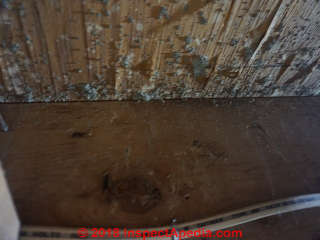 A competent onsite inspection by an expert - a real one who knows both mold and fire damage - usually finds additional clues that help accurately diagnose a problem.
A competent onsite inspection by an expert - a real one who knows both mold and fire damage - usually finds additional clues that help accurately diagnose a problem.
Also your photos are less than one one thousandth of what I'd look at if I were inspecting the building, so any opinion I give is of necessity incomplete.
Photo: mold growth on water-damaged plywood subflooring.
That said, here are some things to consider:
- By your account the seller was not forthcoming about the prior fire.
However if proper inspection, assessment and repairs were made, the house may not be facing a costly fire-damage repair at all. Nevertheless, there might be some residual impact on the property value at re-sale time. - It is common practice to paint over fire damaged wood provided the wood is not structurally compromised - to seal in odors. Painting over fire blackened wood is not harmful.
- It is possible to distinguish between mold and fire damage:
A careful inspection of the painted areas and the surrounding material can often sort out the difference between fire-damaged surfaces that were painted and mold-contaminated surfaces that were coated, as I elaborate below. - Fires do create a secondary mold risk at a property:
extinguishing a fire, presuming it was extinguished with water, dumps a lot of water into and through the structure. That process, when the fire is in the upper part of the structure in particular, sends a lot of water through lower ceilings and walls. Unless all of those areas are opened, gutted, dried, a future mold problem in those areas is a high risk.
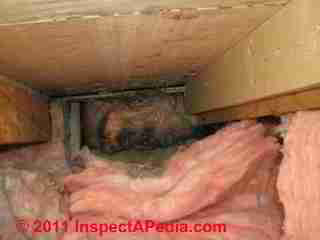
- Your photo of blocked soffits and where no white paint appears (photo at left) and no black marks on sheathing also shows a sister rafter at the right side of the photo - possibly part of a post-fire roof repair/replacement, or sometimes this is done to straighten a sagging roof.
- This photo shows the soffit virtually blocked, black stained fiberglass insulation in the eaves in a pattern that could be due to air movement/air leaks, and thermal tracking. The engineer is correct that roof venting is improper and blocked, risking a moisture and mold problem.
- Your next two photos (below) how white-painted surfaces low at the house eaves on sheathing and some rafters, more sistered rafters, Some of the roof sheathing appears to be plank or T&G boards, other, plywood.
In the photo showing a white-painted sistered rafter under roof sheathing and diagonal bracing (below-right, looks much like a repaired truss),
the paint pattern on the upper truss chord and
the absence of paint and absence of mold on the roof planks that rest atop the sistered/repaired roof truss
form a compelling argument that the paint was applied relating to a fire not mold - mold wouldn't grow on just the truss side and not on the adjoining wood roof decking.
An exception would be if the roof decking was replaced and the old, repaired truss left in place. Usually plank roof decking is older than plywood roof decking.
- Your last photo shows insulation pulled back and what looks like blackened ceiling, studs, and sheathing.
I cannot tell from the photo where in the structure this is, if it is in a moisture path, if there is corroborating indication of surrounding moisture staining on insulation, rusted nails, etc. or if it is left-over charring from the fire.
Given that the (apparently) vertical wall in this last photo is black with something, an astute home inspector who had access to this area during a pre-purchase home inspection would be expected to observe and comment on that anomaly and to warn you of its possible consequences.
Suggestions for Handling Mold & Fire Traces in a Home
 Our photo (left) illustrates extensive fire damage to a home at which the fire originated in a (probably creosote laden) metal chimney venting an overheated woodstove, spread to the building's roof and burned back down the building's wall.
Our photo (left) illustrates extensive fire damage to a home at which the fire originated in a (probably creosote laden) metal chimney venting an overheated woodstove, spread to the building's roof and burned back down the building's wall.
A combination of weather conditions and speed with which demolition and repairs began seemed to avoid a concern for mold contamination associated with water used to extinguish this fire.
- How can I check if I actually have a mold problem in this house ?
An inspection by a expert who is familiar with mold contamination should include a look at the history of the extent of demolition and repair after the fire as well as looking carefully at the water path through the building.
In addition to visual inspection for mold or mold-suspect materials, it makes sense to sample some surface areas especially ones where your engineer thinks that there is a mold problem .
Surface sampling is in order; if you like you can also screen the building for mold using air and dust sampling but the visual inspection and surface samples are most important.
Start by reading MOLD / ENVIRONMENTAL EXPERT, HIRE ?, and for further details on inspecting a building for mold
see MOLD DETECTION & INSPECTION GUIDE - How do I fix the black fire appearance or mold traces in my attic ?
Use sealant paints that are approved for fire restoration to cover or paint over unsightly fire blackened members, presuming that an expert has assured you that no further structural repairs are needed.
Don't paint over mold: moldy surfaces and materials should be physically cleaned. If you want to use a fungicidal sealant afterwards, that's fine.
See ACTION GUIDE - WHAT TO DO ABOUT INDOOR MOLD
and see MOLD SANITIZER, SPRAY, BIOCIDE USE GUIDE - How can I fix the insulation problem in my roof (cathedral part of the roof ?
Attic ventilation, to work effectively, needs continuous air intake at the eaves and outlet at the ridge. Insulation & ventilation contractors use baffles to provide an air path in through vented soffits and add a ridge vent.
See our article series on attic ventilation beginning at ROOF VENTILATION SPECIFICATIONS
...
Continue reading at FIRE DAMAGE vs MOLD DAMAGE or select a topic from the closely-related articles below, or see the complete ARTICLE INDEX.
Or see these
Recommended Articles
- CHIMNEY FIRE ACTION / PREVENTION
- FIRE DAMAGED BUILDINGS, ASSESSMENT, REPAIR
- FIRE DAMAGE vs MOLD DAMAGE
- FIRE RETARDANT TREATED FRT ROOF PLYWOOD
- FIREPLACE INSPECTIONS
- MOLD AGE, HOW OLD is the MOLD?
- MOLD APPEARANCE - WHAT MOLD LOOKS LIKE
- MOLD CLEANUP GUIDE- HOW TO GET RID OF MOLD
- MOLD CONTAMINATION IN BUILDINGS - home
- OIL BURNER SOOT & PUFFBACKS
- PYROLYSIS EXPLAINED
- WILDFIRE DAMAGE PREVENTION for HOMES
Suggested citation for this web page
FIRE RELATED MOLD CONTAMINATION at InspectApedia.com - online encyclopedia of building & environmental inspection, testing, diagnosis, repair, & problem prevention advice.
Or see this
INDEX to RELATED ARTICLES: ARTICLE INDEX to BUILDING DAMAGE, DISASTER, REPAIRS
Or use the SEARCH BOX found below to Ask a Question or Search InspectApedia
Or see
INDEX to RELATED ARTICLES: ARTICLE INDEX to MOLD CONTAMINATION & REMEDIATION
Or use the SEARCH BOX found below to Ask a Question or Search InspectApedia
Ask a Question or Search InspectApedia
Try the search box just below, or if you prefer, post a question or comment in the Comments box below and we will respond promptly.
Search the InspectApedia website
Note: appearance of your Comment below may be delayed: if your comment contains an image, photograph, web link, or text that looks to the software as if it might be a web link, your posting will appear after it has been approved by a moderator. Apologies for the delay.
Only one image can be added per comment but you can post as many comments, and therefore images, as you like.
You will not receive a notification when a response to your question has been posted.
Please bookmark this page to make it easy for you to check back for our response.
Our Comment Box is provided by Countable Web Productions countable.ca
Citations & References
In addition to any citations in the article above, a full list is available on request.
- InspectAPedia.com® - Daniel Friedman - Publisher & Editor.
- Building Failures, Diagnosis & Avoidance, 2d Ed., W.H. Ransom, E.& F. Spon, New York, 1987 ISBN 0-419-14270-3
- Building Pathology, Deterioration, Diagnostics, and Intervention, Samuel Y. Harris, P.E., AIA, Esq., ISBN 0-471-33172-4, John Wiley & Sons, 2001 [General building science-DF] ISBN-10: 0471331724 ISBN-13: 978-0471331728
- Building Pathology: Principles and Practice, David Watt, Wiley-Blackwell; 2 edition (March 7, 2008) ISBN-10: 1405161035 ISBN-13: 978-1405161039
- Diagnosing & Repairing House Structure Problems, Edgar O. Seaquist, McGraw Hill, 1980 ISBN 0-07-056013-7 (obsolete, incomplete, missing most diagnosis steps, but very good reading; out of print but used copies are available at Amazon.com, and reprints are available from some inspection tool suppliers). Ed Seaquist was among the first speakers invited to a series of educational conferences organized by D Friedman for ASHI, the American Society of Home Inspectors, where the topic of inspecting the in-service condition of building structures was first addressed.
- Domestic Building Surveys, Andrew R. Williams, Kindle book, Amazon.com
- Defects and Deterioration in Buildings: A Practical Guide to the Science and Technology of Material Failure, Barry Richardson, Spon Press; 2d Ed (2001), ISBN-10: 041925210X, ISBN-13: 978-0419252108. Quoting:
A professional reference designed to assist surveyors, engineers, architects and contractors in diagnosing existing problems and avoiding them in new buildings. Fully revised and updated, this edition, in new clearer format, covers developments in building defects, and problems such as sick building syndrome. Well liked for its mixture of theory and practice the new edition will complement Hinks and Cook's student textbook on defects at the practitioner level. - Guide to Domestic Building Surveys, Jack Bower, Butterworth Architecture, London, 1988, ISBN 0-408-50000 X
- In addition to citations & references found in this article, see the research citations given at the end of the related articles found at our suggested
CONTINUE READING or RECOMMENDED ARTICLES.
- Carson, Dunlop & Associates Ltd., 120 Carlton Street Suite 407, Toronto ON M5A 4K2. Tel: (416) 964-9415 1-800-268-7070 Email: info@carsondunlop.com. Alan Carson is a past president of ASHI, the American Society of Home Inspectors.
Thanks to Alan Carson and Bob Dunlop, for permission for InspectAPedia to use text excerpts from The HOME REFERENCE BOOK - the Encyclopedia of Homes and to use illustrations from The ILLUSTRATED HOME .
Carson Dunlop Associates provides extensive home inspection education and report writing material. In gratitude we provide links to tsome Carson Dunlop Associates products and services.


